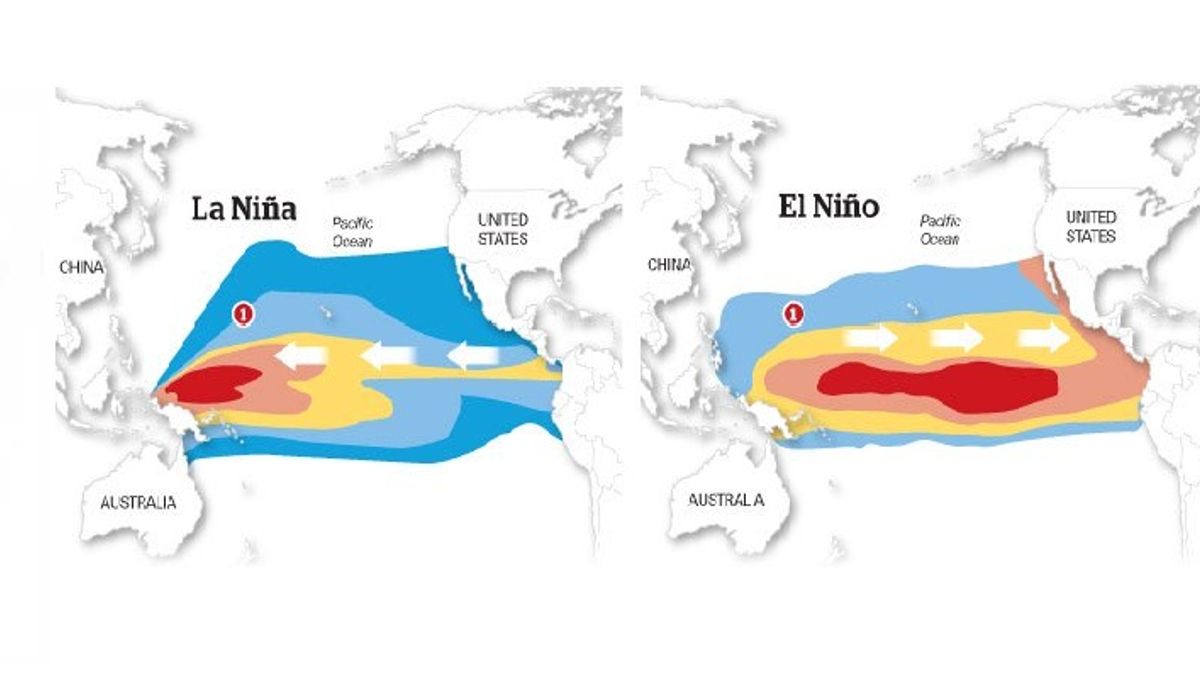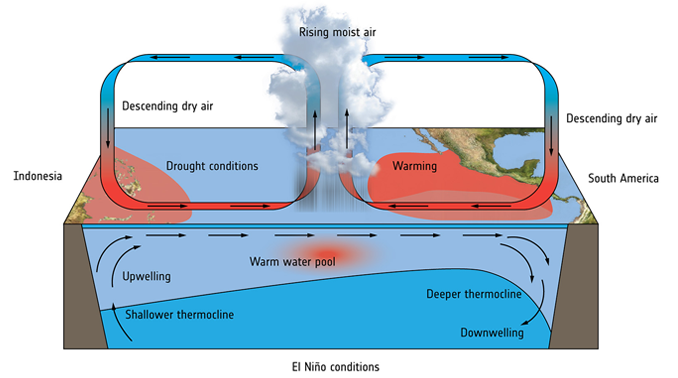As a matter of fact El Nino is more widespread than La Nina. One of the important differences between La Nina and El Nino is in connection with the frequency of their occurrence.

What Are The Differences Between El Nino And La Nina
La Nina on the other stands for little girl and denotes a cold event or a cold episode.

. Derived from the Spanish term which represents little boy. La Niña is the opposite a cooling phase of ENSO that tends to have global climate impacts opposite to those of it. Scientists call these phenomena the El Niño-Southern Oscillation ENSO cycle.
El Niño and La Niña are naturally recurring climate disruptions that can cause significant changes in rainfall and temperature across the globe. El Niño events are associated with a warming of the central and eastern tropical Pacific while La Niña events are the reverse with a sustained cooling of these same areas. La Nina causes sinking motion in the Pacific and rising motion in the Atlantic.
It represents the cold phase of the ENSO cycle. El Nino occurs when tropical Pacific ocean trade winds die out and ocean temperatures become usually worm. As for La Nina think of it as the opposite of El Nino.
Its a bit of a scientific dance between ocean and atmosphere with the opposite ends of the spectrum known as El Niño the warm phase and La Niña the cold phase. Press J to jump to the feed. These changes can lead to wildfires droughts widespread flooding and even outbreaks of disease.
La Niña refers to the periodic cooling of sea-surface temperatures across the east-central equatorial Pacific. Normally strong trade winds blow from the east along the equator pushing warm water into the western Pacific Ocean. The difference between El Niño and La Niña We believe in One Planet Thriving Join us in the fight for a Healthy Thriving Planet BECOME AN EO MEMBER TODAY First El Niño means the little boy in Spanish and La Niña the little girl.
Between these two phases is a third phase called ENSO-neutral. These changes in the Pacific Ocean and its overlying atmosphere occur in a cycle known as the El NiñoSouthern Oscillation ENSO. It is said that El Nino occurs more frequently than La Nina.
El Niño events are associated with a warming of the central and eastern tropical Pacific while La Niña events are the reverse with a sustained cooling of these same areas. These changes in the Pacific Ocean and its overlying atmosphere occur in a cycle known as the El NiñoSouthern Oscillation ENSO. Both El Niño and La Niña can last more than a year but it is rare for El Niño events to last longer than a year or so while it is common for La Niña to last for two years or more.
It represents the warm phase of the ENSO cycle. We work hard El Nino and La Nina are of opposite phases of the El Nino southern oscillation commonly called as ENSO it is associated with the band of warm ocean water which is formed in the central and east-central equatorial p View the full answer. El Niño conditions occur when abnormally warm waters.
El Niño and La Niña are two opposing climate patterns that break these normal conditions. El Niño is a Spanish term meaning little boy while La Niña is also a Spanish term meaning little girl El Niño is associated with warmer water in the Pacific Ocean along the equator while La Niña is. Together these extreme phases are called the El Niño-Southern Oscillation.
Please give thumbs up. The longest El Nino in the modern record lasted 18 months while. 2El NiÃo is the more prevalent phenomenon of the two whereas La Nina makes an appearance every few years.
There will be stronger trade winds and cooler surface water temperatures. Explain Like Im Five is the best forum and archive on the internet for layperson-friendly. La Niña refers to the periodic cooling of sea.
El nino Unusally warm water temps im the oacific cause by a weak or reversed direction trade winds La Niña Unusually cold water temps in the pacific caused by strong easterly winds La Niña characteristics Cooling of the water in the Pacific Ocean Less Precipitation Decreased Humidity Unusually cold weather in Alaska. Press question mark to learn the rest of the keyboard shortcuts. La Nina means the little girl The pattern is the opposite of El.
El Nino typically involves waters with a warmer than usual surface temperature a flatter thermocline cooler water moves to the surface and weaker trade winds. El Niño refers to the above-average sea-surface temperatures that periodically develop across the east-central equatorial Pacific. La Nina exists when cooler than usual ocean temperatures occur on the equator between South America and the Data Line.
However it will be useful to list some of the key differences Between The Two Phenomena. El Niño and La Niña can both have global impacts on weather wildfires ecosystems and economies. Episodes of El Niño and La Niña typically last nine to 12 months but can sometimes last for years.
El Niño and La Niña are the extreme phases of the ENSO cycle. In fact since 1975 La Ninas have been only half as frequent as El Ninos. 1In Spanish El NiÃo stands for child Christ and since this phenomenon would occur around Christmas the name stuck.
While an El Niño is an anomalous warming of the central and eastern equatorial Pacific ocean a La Niña is an anomalous cooling of the same area. Difference between El Nino and La Nina. It accompanies low air surface pressure in the Eastern Pacific.
It represents the warm phase of the ENSO cycle. The change it causes to Sea Surface Temperatures SST will influence our winter weather. El Niño refers to the above-average sea-surface temperatures that periodically develop across the east-central equatorial Pacific.
Both patterns tend to happen every 3-7 years and play a big part in how warm or cold US winters will be.

Vol 66 Getting To Know El Nino La Nina Aha Centre The Column

0 Comments